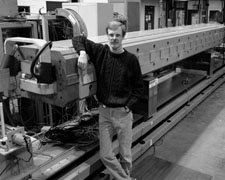 |

Building the Main Injector We faced all the curveballs that fortune could throw us. Fortunately we smacked a few over the fence…. by Stephen D. Holmes, Main Injector Project Manager Creating something on the scale of the Main Injector is not the work of one person. The successful completion of this newest Fermilab accelerator represents the attainment of a vision shared by literally hundreds of people: politicians and laborers, engineers and contract administrators, technicians and laboratory managers, scientists and accountants, surveyors and electricians, drafters and plumbers, welders and riggers, government officials and machinists... nearly everyone associated with Universities Research Association, Fermilab and the world high energy physics community. My role in this enterprise has been to guide a large group of very talented people in defining what we want to do, help them when obstacles arose, and stay out of the way when things went smoothly. The Main Injector has been a decade in the making. My involvement began with a request in 1987 from Helen Edwards, the Accelerator Division head, to Gerry Dugan, John Marriner and me to undertake a study of how Fermilab could enhance the performance of the Tevatron beyond its original (but as-yet-to-be achieved) performance goals, by integrating a new accelerator or accelerators within the existing complex. We wrote a report identifying several possibilities, all with a common strategy—produce more antiprotons for the collider. Building on this report, we completed and estimated the costs for several designs. They included constructing two new accelerators operating at 20 GeV and constructing a second Tevatron (for proton-proton collisions), supported by a new Main Ring. We finally settled on a Main Ring replacement supporting continued proton-antiproton collisions in the existing Tevatron as providing the most bang for the buck. Fermilab proposed the project to the Department of Energy in January 1989. Many people wonder about the name for the new accelerator. Helen suggested "Main Injector," because the accelerator was destined to replace the "Main Ring." There were significant challenges in the early days gaining support for the accelerator both within the high-energy physics community and in Congress. Getting the project off the ground in October, 1991, benefited from the support of many people, including the Illinois congressional delegation, the Governor’s office, and an advocacy group called the Illinois Coalition. I remember the first meeting we had with the Illinois Coalition. The chairman, David Baker, started the meeting by saying the first agenda item was to develop a better name. "Main Injector," he felt, conjured up images of a bad trip to the doctor’s office. We spent several hours discussing this but never came up with anything better. Funding for the Main Injector Project was approved starting in October 1991. After an extended design and R&D period, the construction really got underway in the spring of 1993. Over the years, the team working on the accelerator has experienced literally thousands of small victories and some not-so-small setbacks. From Coopers’ hawks (an Illinois threatened species) nesting in trees we were trying to cut down, to stopped-up drainage systems, to floods of the enclosures, to transformers refusing to pass acceptance tests, to microbes attacking the water system, to magnet compensator going down with the ship during a storm in the Atlantic, we faced all the curveballs that fortune could throw us. Fortunately we smacked a few over the fence, allowing for the addition of a second storage ring, the Recycler, to the complex and still completing the project on budget and on schedule. The completion of the Main Injector represents not an end but a beginning. It will take great effort to realize its full potential for the improvement of the research program at Fermilab. However, with the Main Injector now operational, we have taken a big step along this road. As we embark, we can reflect on how things have gone, as well as how they will go. As on any project there were times when we did not see how we could succeed, and other times we did not see how we could fail. At last, we have reached a point where we can see clearly that Fermilab will reap the benefits of this new accelerator, the Main Injector, for decades to come. |
| last modified 6/1/1999 email Fermilab |
FRLsDFx9eyfrPXgV